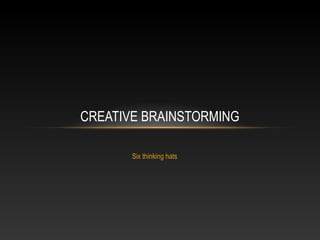Creative brainstorming six thinking hats
- 2. CONTENTS • Understand importance of thinking • Argumentative vs. Parallel thinking • Introduction of Six Thinking Hats • Benefits of using Six Thinking Hats • Details of Six Thinking Hats • Usage in Work life • Testimonials
- 3. THINKING ABOUT THINKING • Thinking defines quality of life including work performance, relationships and growth • No problem can withstand the assault of sustained thinking. - Voltaire • A pessimist sees the difficulty in every opportunity; an optimist sees the opportunity in every difficulty. – Abraham Lincoln
- 4. THINKING ABOUT THINKING • The main difficulty of thinking is confusion • Thinking is not same all the times; varies as per day, weather, mood, topic, vision of futue • Difficulties in involving participants actively in meetings. • Difficulties in changing long held perceptions of self and others Can thinking be controlled or directed to get better outcomes/decisions?
- 5. ARGUMENTATIVE VS. PARALLEL THINKING • Argumentative – in a discusion each party deliberatly takes an opposite view • Parallel – each party looks in parallel from the same point of view • Argumentative – in case of disagreement one party tries to prove other party wrong • Parallel – both views of disagreement are put down in parallel. Decision is made, if required, later on • Argumentative – Generally based on “What is” • Parallel – based on “What Can be„
- 6. SIX THINKING HATS • Tool by Edward De Bono to implement parallel thinking in group • Six colored hats correspond to six directions of thinking – white, red, black, yellow, green, blue • Set of rules to be followed by everyone Edward De Bono gave the concept of lateral thinking and his tools are widely used in Government and educational & commercial enterprises.
- 8. SIX THINKING HATS - BENEFITS • Maximum utilisation of intelligence, experience and knowledge of all the participants • Huge time savings as members are thinking in parallel rather than argumenting • Uses ego constructively in discussions • In Argumentative thinking, ego is biggest obstacle to quick and effective thinking. • One thing (information, emotions, caution, creativity, optimism, control) at a time • Confusion is the biggest enemy of good thinking
- 9. SIX THINKING HATS - DETAILS
- 10. SIX THINKING HATS – BENEFITS • Brain is more sensitised to problems/issues than positive value in situation/idea • Will help in finding positive values by deliberate effort and removing confusion • Many great opportunities are lost just due to wrong assumptions and negative thinking • Will help in assessing opportunities objectively by balancing emotions and creativity • Customer and senior management always want solution and not problems • Will help in finding 3-4 creative solutions to problems
- 11. SIX THINKING HATS – HOW TO Guidelines • There is no one right sequence to follow • Some sequences are appropriate for exploration, some for problem solving, for dispute settlement , for decision making, and so forth A Blue hat should always be used both at the beginning and at the end of the session
- 12. SIX THINKING HATS – 1ST BLUE HAT • Why we are here • What we are thinking about • The defintion of the situation (or problem) • Alternative defintions • What we want to acheive • Where we want to end up • The background to the thinking, and • A plan for the sequence of hats to be used
- 13. SIX THINKING HATS – LAST BLUE HAT • What we have acheived, • Outcome, • Conclusion, • Design, • Solution and • Next steps
- 14. SIX THINKING HATS – TESTIMONIALS • NASA, IBM, DuPont, NTT, Shell, BP, Federal Ex and others • Use six thinking hats successfuly for problem solving effectively and creatively • Optus (Australia) • Discussion is concluded in 45 minutes only even planned time was 4 hours • ABB • Cuts short project discussion time from 20 days to 2 days














